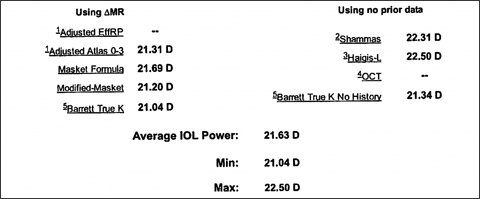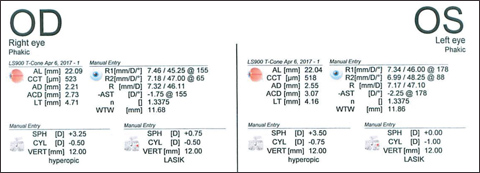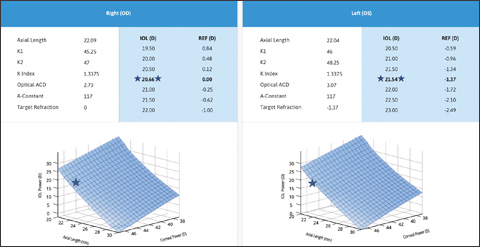IOL calculations in eyes with prior hyperopic LASIK
When making the calculations, it is ideal to have pre-LASIK measurements, post-LASIK results and pre-cataract surgery biometry.
We know that patients who underwent prior corneal refractive surgery pose more of a challenge when it comes to performing IOL calculations for cataract surgery. The reason is that the anterior surface of the cornea has been steepened while the posterior surface has been untouched. Thus, the typical ratio of anterior to posterior curvature has been altered, and our instrumentation has a difficult time accurately determining total central corneal power.
Newer instrumentation has provided some degree of assistance. We have tomographers such as the dual Scheimpflug devices, which allow us to read the anterior and posterior corneal surfaces at the preoperative visit. Anterior segment OCT allows us to map the corneal epithelium to provide additional insight. Online calculators have multiple different methods for IOL power calculation in these eyes (Figure 1), but they each seem to provide a different answer. With so many different solutions to the question of ideal IOL power, how do you select from the choices?
Looking at preoperative data
Ideally, we want three sets of data: the pre-LASIK measurements, the post-LASIK results and the pre-cataract surgery biometry. The difference between the pre-LASIK and post-LASIK refraction tells us the net effect of the corneal refractive surgery. Similarly, comparing pre-LASIK keratometry to post-LASIK data shows us the degree of corneal steepening that was achieved. The pre-cataract surgery biometry will tell us the current state of the eye, including the axial length and the apparent keratometry. Care should be taken when assessing the pre-cataract surgery refraction because the development of the cataract can induce a refractive shift in the eye, such as the myopic shift seen from advancing nuclear sclerosis. The pre-cataract surgery topography is also a key piece of data because it shows us the size of the optical zone, the degree of steepening and the astigmatic axis (Figure 2).

Source: Uday Devgan, MD

Learning from an example
In the case study here, a patient underwent hyperopic LASIK at the age of 68 years and now presents to you at age 72 years for cataract surgery. Her preoperative LASIK data show that she had a refraction spherical equivalent of +3.00 in the right eye and +3.12 in the left eye, and her pre-LASIK best corrected vision was 20/30 in each eye. Although the records do not describe it, there was almost certainly some degree of cataract change at age 68, and a better option than LASIK would have been to do early IOL surgery. Nonetheless, the LASIK surgeon did laser vision correction of +3.00 in the right eye and +4.25 in the left eye, ostensibly for a mild degree of monovision by targeting the left eye for mild myopia. Post-LASIK, the patient achieved a refraction of +0.75 –0.50 × 165 in the right eye and 0.00 –1.00 × 180 in the left eye.
Measurement of the axial length shows a value of about 22 mm in each eye, steep corneas and a normal anterior chamber depth (Figure 3). Using the standard methods for IOL power calculation will underestimate the corneal power, thereby calculating a larger IOL power and resulting in a postoperative myopic surprise. In general, the error estimation is about one-third of the laser treatment in the opposite direction. In this case, a treatment of about +3 D is expected to produce an error of about –1 D in postop refractive outcome if we do not adjust the IOL power calculation.
A decision was made to do cataract surgery on the patient’s nondominant left eye, which as you recall from above was targeted with and achieved mild myopia after LASIK. When all of the available data are plugged into the ASCRS calculator, we see that the average of the methods results in an estimated IOL power of +21.5 for a postop goal of mild myopia of about –0.25 D (Figure 1). The standard IOL calculations for a virgin eye performed at IOLcalc.com give a result of +22.5, and then taking into account the adjustment of –1 D, it would result in the same estimation of +21.5 for the IOL power (Figure 4). Surgery was successfully done, and the patient was given a few weeks to heal. The final refractive result for the left eye was a spherical equivalent of –1.37 D of myopia. She achieved excellent near vision, but she still desires better distance vision.


So now, how do we calculate the right eye, which is the more critical one because we must achieve a target of close to plano and make the patient happy? The left eye ended up –1.37 D with an IOL power of +21.5, so that means that ideal IOL power for our goal of –0.25 D would be about +20.0 because for most eyes, 1.5 D at the IOL plane will give us about 1 D at the spectacle plane. We can also go back to www.IOLcalc.com and recalculate and adjust our A-constant to give us the actual results. For the left eye, using an A-constant of 117 will give us the actual results that we achieved; implanting a +21.5 IOL will give the left eye a postop refraction of –1.37 D spherical equivalent. Remember that this new A-constant of 117 is specific to this patient and takes into account the prior corneal refractive surgery and other factors all at once.
Now let’s use the same 117 A-constant for the right eye, and without doing any further adjustments regarding the LASIK surgery, we can aim for a postop goal of plano and see that the ideal IOL power will be about +20.5 for a spherical equivalent of +0.12 D. This is the IOL that was implanted in the right eye, and indeed, a postop goal of plano was achieved and the patient is now very happy with her resultant vision.
- For more information:
- Uday Devgan, MD, is in private practice at Devgan Eye Surgery, Chief of Ophthalmology at Olive View UCLA Medical Center and Clinical Professor of Ophthalmology at the Jules Stein Eye Institute, UCLA School of Medicine. He can be reached at 11600 Wilshire Blvd. #200, Los Angeles, CA 90025; email: devgan@gmail.com; website: www.DevganEye.com.
Disclosure: Devgan reports he is a principle in www.IOLcalc.com, which offers free IOL calculations to all surgeons.







